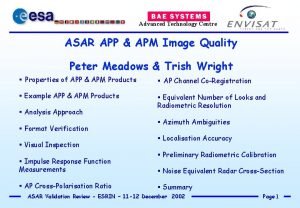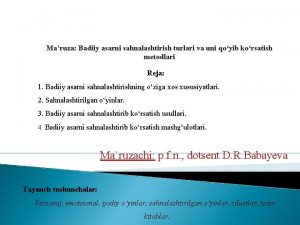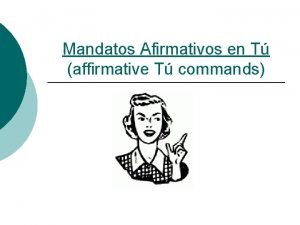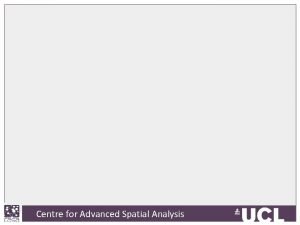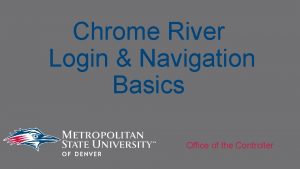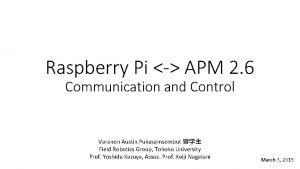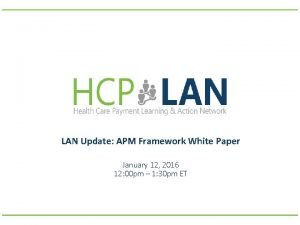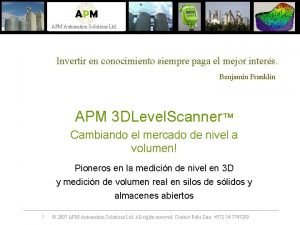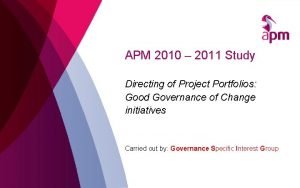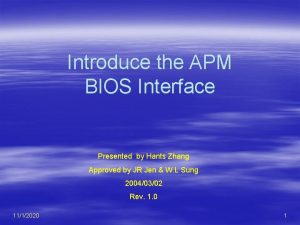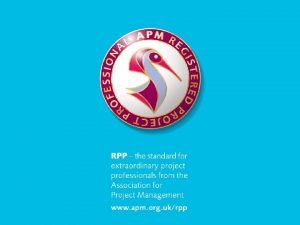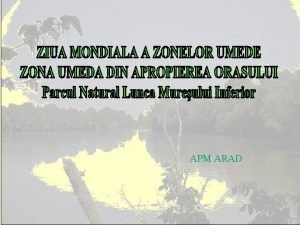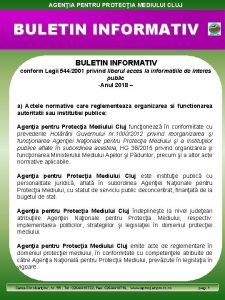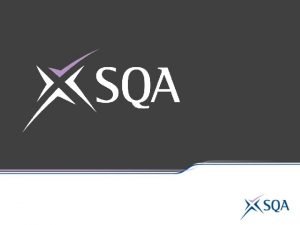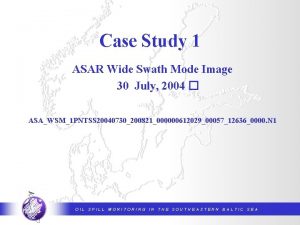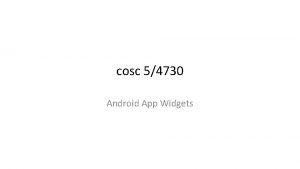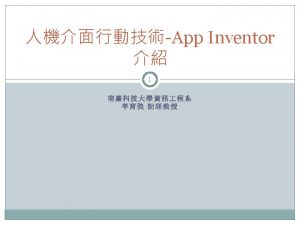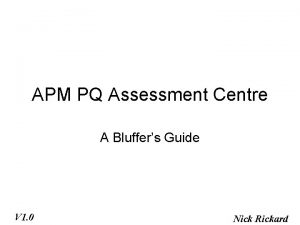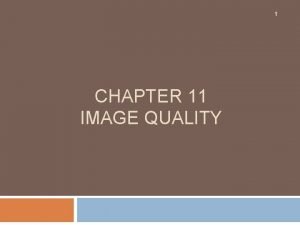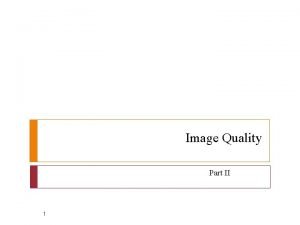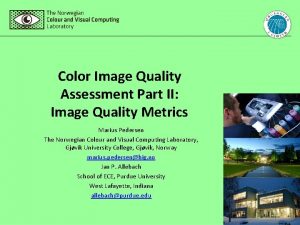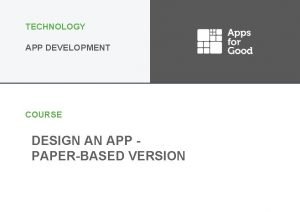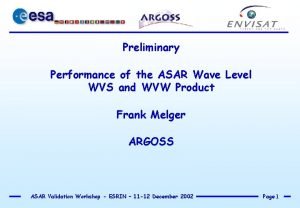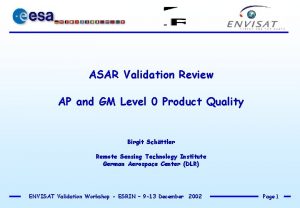Advanced Technology Centre ASAR APP APM Image Quality






























- Slides: 30

Advanced Technology Centre ASAR APP & APM Image Quality Peter Meadows & Trish Wright § Properties of APP & APM Products § AP Channel Co-Registration § Example APP & APM Products § Equivalent Number of Looks and Radiometric Resolution § Analysis Approach § Format Verification § Visual Inspection § Impulse Response Function Measurements § AP Cross-Polarisation Ratio § Azimuth Ambiguities § Localisation Accuracy § Preliminary Radiometric Calibration § Noise Equivalent Radar Cross-Section § Summary ASAR Validation Review - ESRIN – 11 -12 December 2002 Page 1

Advanced Technology Centre Properties of APP Imagery • • Ground range detected alternating polarisation imagery Dual polarisation (HH & VV, HH and HV or VV & VH) Elevation antenna pattern and range spreading loss corrections applied Size up to 300 Mbytes with 2 byte (16 bit) amplitude pixel values Swath widths of 100 km (IS 1) to 56 km (IS 7) with azimuth extents of ~100 km Azimuth resolution of 27. 6 m (2 looks of ~250 Hz each) Range resolution from 21 m (IS 2 far range) to 37 m (IS 1 near range) and ~26 m for IS 3 to IS 7 (1 look) 12. 5 m by 12. 5 m pixels (hence under-sampling for spatial resolutions less than 25 m) ASAR Validation Review - ESRIN – 11 -12 December 2002 Page 2

Advanced Technology Centre Properties of APM Imagery • • Ground range detected alternating polarisation medium resolution imagery Dual polarisation (HH & VV, HH and HV or VV & VH) Elevation antenna pattern and range spreading loss corrections applied Size up to few Mbytes with 2 byte (16 bit) amplitude pixel values Swath widths of 100 km (IS 1) to 56 km (IS 7) with azimuth extents of ~100 km up to 4000 km Azimuth resolution of 135 m (10 looks of ~50 Hz each) Range resolution from 109 m (IS 1 far range) to 163 m (IS 1 near range) and ~130 m for IS 3 to IS 7 (1 look) 75 m by 75 m pixels ASAR Validation Review - ESRIN – 11 -12 December 2002 Page 3

Advanced Technology Centre APP & APM Products • • • The blue orbit numbers are of The Netherlands and the purple are of Resolute, Canada. All products are processed with v 3. 03 No IS 1 data Two APP products had saturated ASAR transponders (orbits 3812 & 3855) ASAR Validation Review - ESRIN – 11 -12 December 2002 Page 4

Advanced Technology Centre Example APP Products 14 July 2002 IS 2 HV & HH Ottawa, Canada ASAR Validation Review - ESRIN – 11 -12 December 2002 Page 5

Advanced Technology Centre 6 November 2002 IS 2 HV & HH Resolute, Canada ASAR Validation Review - ESRIN – 11 -12 December 2002 Page 6

Advanced Technology Centre 6 November 2002 IS 2 HV & HH The Netherlands ASAR Validation Review - ESRIN – 11 -12 December 2002 Page 7

Advanced Technology Centre Example APM Products 9 November 2002 IS 3 HV & HH ASAR Validation Review - ESRIN – 11 -12 December 2002 Page 8

Advanced Technology Centre 12 November 2002 IS 3 VV & VH ASAR Validation Review - ESRIN – 11 -12 December 2002 Page 9

Advanced Technology Centre Analysis Approach 1. 2. Format verification using Envi. View & the ESA SAR Product Control Software (developed by DLR & BAE Systems) Image analysis performed using SAR Control Software (point target & calibration modules) and following the ESA document on Quality Measurement Definitions for ASAR products Format Verification • No problems identified with APP & APM format or header parameters, however many of the APP products had no Chirp Parameter ADSR (hence no annotated Chirp Powers) Visual Inspection • No problems found with any post Orbit 3661 v 3. 03 APP or APM products ASAR Validation Review - ESRIN – 11 -12 December 2002 Page 10

Advanced Technology Centre Impulse Response Function Measurements (APP) • IRF parameters have been derived using the ESA transponders in The Netherlands and the Radarsat transponders in Canada (images 1. 6 by 1. 6 km). Aalsmeer (HV) Edam (HH) Edam (HV) Swifterbant (HV) Edam (VV) Zwolle (VH) Fredericton (HV) ASAR Validation Review - ESRIN – 11 -12 December 2002 Resolute (HH) Resolute (HV) Page 11

Advanced Technology Centre Example APP Impulse Response Functions Radarsat transponder, i = 15. 81°, azimuth resolution = 27. 49 m, range resolution = 34. 70 m ASAR transponder, i = 23. 85°, azimuth resolution = 27. 83 m, range resolution = 24. 14 m ASAR Validation Review - ESRIN – 11 -12 December 2002 Page 12

Advanced Technology Centre Spatial Resolution (3 d. B width of IRF): • Azimuth resolution (y): 28. 09± 1. 97 m (c. f. ~27. 6 m theoretical value, +10% limit & 30 m requirement) • Range resolution (x): (c. f. theoretical values, +10% limit & <38 m requirement for IS 1 and <30 m requirement for IS 2 - IS 7) Note that the IS 1 swath extends to 22. 2° and that the IS 2 swath starts at 19. 2°. ASAR Validation Review - ESRIN – 11 -12 December 2002 Page 13

Advanced Technology Centre Integrated Sidelobe Ratio (ratio of energy in the sidelobes up to a box 20 x by 20 y to the energy in the mainlobe(2 x by 2 y)): • -12. 87± 1. 44 d. B (c. f. -12. 4 d. B theoretical value, +5 d. B limit & < -12 d. B requirement) Peak Sidelobe Ratio (ratio of the intensity of the most intense peak outside the main lobe up to 10 x by 10 y to the energy in the mainlobe): • -19. 07± 0. 94 d. B (c. f. -21. 2 d. B theoretical value, +5 d. B limit & < -20 d. B requirement) Spurious Sidelobe Ratio (ratio of the intensity of the most intense peak outside 10 x by 10 y up to 20 x by 20 y to the energy in the mainlobe): • -25. 98± 2. 20 d. B (c. f. <-25 d. B requirement) ASAR Validation Review - ESRIN – 11 -12 December 2002 Page 14

Advanced Technology Centre Impulse Response Function Measurements (APM) • IRF parameters have been derived using the ESA transponders in The Netherlands and the Radarsat transponders in Canada (images 4. 8 by 4. 8 km): Aalsmeer (VH) Aalsmeer (HV) Edam (VH) Edam (HV) Swifterbant (VH) Zwolle (VH) ASAR Validation Review - ESRIN – 11 -12 December 2002 Resolute (HH) Resolute (HV) Page 15

Advanced Technology Centre Example APM Impulse Response Functions ASAR transponder, i = 25. 36°, azimuth resolution = 145. 9 m, range resolution = 122. 1 m Radarsat transponder, i = 44. 22°, azimuth resolution = 144. 0 m (HV) & 143. 7 m (HH), range resolution = 132. 0 m (HV) & 133. 9 m (HH) ASAR Validation Review - ESRIN – 11 -12 December 2002 Page 16

Advanced Technology Centre Spatial Resolution (3 d. B width of IRF): • Azimuth resolution (y): 143. 9± 5. 9 m (c. f. ~135 m theoretical value & +10% limit) • Range resolution (x): (c. f. theoretical values & +10% limit) Note that the measurements are to 1/8 pixel (9. 4 m) and that APM products are undersampled if the resolution is < 150 m. ASAR Validation Review - ESRIN – 11 -12 December 2002 Page 17

Advanced Technology Centre Integrated Sidelobe Ratio (ratio of energy in the sidelobes up to a box 20 x by 20 y to the energy in the mainlobe(2 x by 2 y)): • -12. 37± 1. 55 d. B (c. f. -12. 4 d. B theoretical value, +5 d. B limit & <-12 d. B requirement) Peak Sidelobe Ratio (ratio of the intensity of the most intense peak outside the main lobe up to 10 x by 10 y to the energy in the mainlobe): • -16. 62± 2. 57 d. B (c. f. -21. 2 d. B theoretical value, +5 d. B limit & <-20 d. B requirement) Spurious Sidelobe Ratio (ratio of the intensity of the most intense peak outside 10 x by 10 y up to 20 x by 20 y to the energy in the mainlobe): • -21. 34± 2. 55 d. B (c. f. <-25 d. B requirement) ASAR Validation Review - ESRIN – 11 -12 December 2002 Page 18

Advanced Technology Centre AP Cross-Polarisation Ratio The ratio of the total power in the IRF of an ASAR transponder in both channels. Examples of IRF in second polarisation: Aalsmeer (HH) • Edam (HV) Swifterbant (HH) Average APP cross-pol ratio (17 measurements): -32. 1± 4. 2 d. B (c. f. predicted value of < -35 d. B). Caused by ASAR and/or transponders ASAR Validation Review - ESRIN – 11 -12 December 2002 Page 19

Advanced Technology Centre AP Channel Co-registration The mis-registration between the two channels computed from the difference in the location of a point target IRF peak in both channels. As the Resolute transponders give strong IRF’s in all polarisations, they have been used for the co-registration: • APP products (2 measurements): 0. 0 m & 0. 0 m • APM products (2 measurements): 9. 4 m & 0. 0 m ASAR Validation Review - ESRIN – 11 -12 December 2002 Page 20

Advanced Technology Centre Equivalent Number of Looks and Radiometric Resolution Equivalent number of looks and radiometric resolution are derived using uniform distributed targets. APP co-polarisation measurements (4 measurements): • • Mean equivalent number of looks: 1. 99± 0. 05 (c. f. >1. 9 requirement, -10% limit) Mean radiometric resolution: 2. 32± 0. 03 d. B (c. f. <2. 37 d. B requirement) APM co-polarisation measurements (16 measurements): • • Mean equivalent number of looks: 56. 1± 16. 8 (c. f. > 30 requirement, -10% limit) Mean radiometric resolution: 0. 56± 0. 09 d. B (c. f. < 0. 7 d. B requirement) ASAR Validation Review - ESRIN – 11 -12 December 2002 Page 21

Advanced Technology Centre Azimuth Ambiguities As Doppler frequencies can only be distinguished modulo the PRF, azimuth ambiguities occur within the azimuth antenna pattern sidelobes. Measurement requires either a very bright point target or a bright point target with a low ambiguity background radar cross-section. Average APP ambiguity ratio: • ASAR Transponders: -27. 9± 2. 6 d. B Average APM ambiguity ratio: • ASAR Transponders: -28. 7± 1. 9 d. B The requirement is -25 d. B while the worst case prediction is ~ -27. 9 d. B. ASAR Validation Review - ESRIN – 11 -12 December 2002 APM Edam (VH) Page 22

Advanced Technology Centre Localisation Accuracy The difference between the measured and predicted positions of the ASAR transponder. The predicted positions are based on image header parameters, the known location of the transponders and their time delay. The ASAR transponders have a small terrain height and hence a small range terrain displacement. APP measurements: • • • Mean range displacement: -3. 8± 26. 3 m Mean azimuth displacement: -12. 9± 60. 1 m Mean displacement: 57. 8± 30. 9 m ASAR Validation Review - ESRIN – 11 -12 December 2002 Page 23

Advanced Technology Centre The localisation accuracy requirement is <900 m while the worst case prediction is ~75 m in azimuth and between ~125 m (IS 1) and ~50 m (IS 7) in range. ASAR Validation Review - ESRIN – 11 -12 December 2002 Page 24

Advanced Technology Centre Preliminary Radiometric Calibration The ASAR APP transponders have been used to give a preliminary radiometric calibration for swaths IS 2 to IS 7. As the v 3. 03 AP products seem to have been processed with IM nominal chirp powers, corrections have been applied to all AP radar cross-section measurements. ASAR Validation Review - ESRIN – 11 -12 December 2002 Page 25

Advanced Technology Centre • • • APP K for swaths IS 2 to IS 4 is: 57. 05± 0. 51 d. B APP K for swaths IS 5 to IS 7 is: 60. 59± 0. 47 d. B (based on nonsaturated ASAR transponders) Different K values due to different product scaling factors ASAR Validation Review - ESRIN – 11 -12 December 2002 Page 26

Advanced Technology Centre The derived APM calibration K is: 69. 47± 0. 50 d. B (based on ASAR transponders with acceptable ISLR’s) Further measurements required before definitive calibration constants can be derived ASAR Validation Review - ESRIN – 11 -12 December 2002 Page 27

Advanced Technology Centre Noise Equivalent Radar Cross-section NESigma 0 estimated using low radar cross-section regions (ocean, open water or lakes). This gives an upper limit to NESigma 0. HV APP polarisation measurements: ASAR Validation Review - ESRIN – 11 -12 December 2002 Page 28

Advanced Technology Centre Summary • • 10 v 3. 03 APP and APM IS 2 to IS 7 products analysed No format problems identified but many of the APP products had no Chirp Parameter ADSR (hence no annotated Chirp Powers) No visualisation problems found with any post Orbit 3661 v 3. 03 products APP azimuth & range resolutions, ISLR, PSLR & SSLR acceptable. Some range under-sampling APM Azimuth & range resolutions and ISLR acceptable. PSLR & SSLR outside expected range due to APM under-sampling in both azimuth and at almost all ground ranges Acceptable APP cross-polarisation ratio Sub-pixel AP channel co-registration ASAR Validation Review - ESRIN – 11 -12 December 2002 Page 29

Advanced Technology Centre • • • APP & APM equivalent number of looks and radiometric resolution acceptable APP & APM azimuth ambiguities acceptable APP Localisation accuracy good Preliminary calibration constants derived - more work required before definitive K values can be calculated. Noise equivalent radar cross-sections lower than predicted NESigma 0 ASAR Validation Review - ESRIN – 11 -12 December 2002 Page 30
 Apm calibration centre
Apm calibration centre Shneim asar chodesh
Shneim asar chodesh Kesimpulan solat jamak dan qasar
Kesimpulan solat jamak dan qasar Boburnoma samarqand tasviri
Boburnoma samarqand tasviri Shneim asar chodesh
Shneim asar chodesh Badiiy asar turlari
Badiiy asar turlari Mandatos afirmativos con tu
Mandatos afirmativos con tu Asar status
Asar status Centre for advanced spatial analysis
Centre for advanced spatial analysis Chrome river app login
Chrome river app login Intune mdm
Intune mdm Centroid in engineering mechanics
Centroid in engineering mechanics Center of gravity for different shapes
Center of gravity for different shapes Connect apm to raspberry pi
Connect apm to raspberry pi Dynatrace azure
Dynatrace azure Cdphp enhanced primary care
Cdphp enhanced primary care Maximo pam
Maximo pam Apm terminals headquarters
Apm terminals headquarters Apm automation
Apm automation Apm 2010
Apm 2010 Apm testing florida
Apm testing florida Apm benefits management
Apm benefits management Ap/m permaform
Ap/m permaform Cpu apm function
Cpu apm function Pacportal tim
Pacportal tim Apm rpp
Apm rpp Apm ourplace
Apm ourplace @notsoplainjanejane:https://youtu.be/vpae9nj7too
@notsoplainjanejane:https://youtu.be/vpae9nj7too Apm arad
Apm arad Anpm cluj
Anpm cluj Understanding standards advanced higher geography
Understanding standards advanced higher geography
